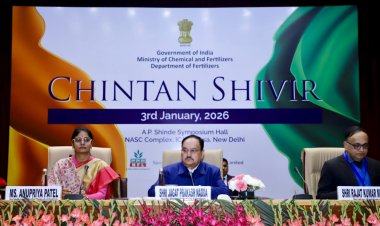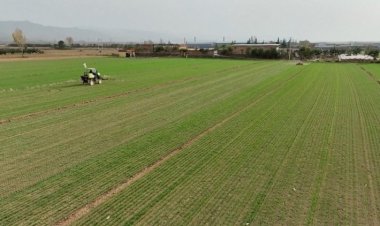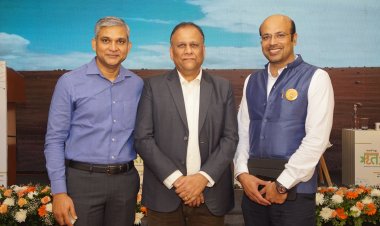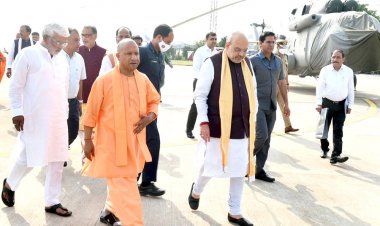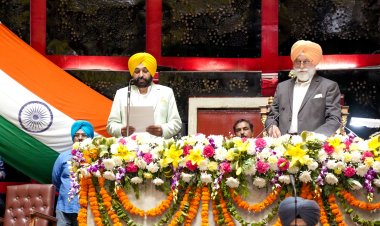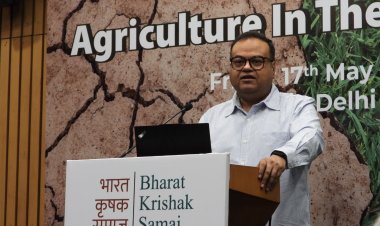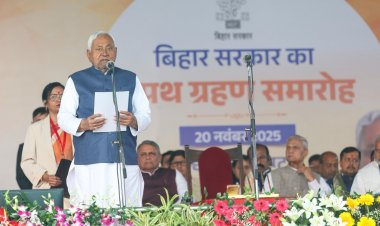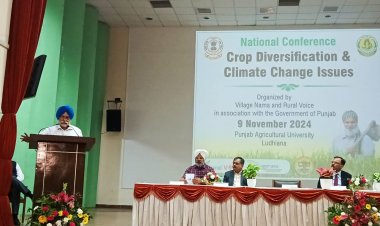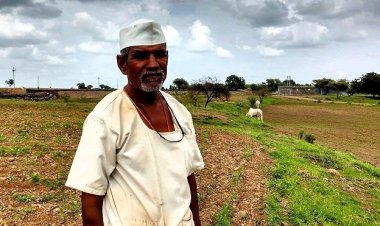States should now move forward on agricultural reforms: Prof Ramesh Chand
According to NITI Aayog member Prof. Ramesh Chand, states have greater responsibility towards the agricultural sector, they should make laws according to their circumstances. For the last 10 years, our growth in agricultural productivity has been higher than that of China and America, hence the yield gap has started reducing.

According to NITI Aayog member Prof. Ramesh Chand, states have greater responsibility towards the agricultural sector, they should make laws according to their circumstances. For the last 10 years, our growth in agricultural productivity has been higher than that of China and America, hence the yield gap has started reducing. NITI Aayog member Professor Ramesh Chand is a world-renowned agricultural economist. His imprint is always visible in the determination of agricultural policies of the country. Being an agricultural economist, he has written many papers and books. Recently, his important paper has come out on Indian agriculture regarding the Green Revolution and Amrit Kaal, in which he has tried to lay out a roadmap for the future of the country's agricultural sector. In a long interview with Rural Voice and Rural World Editor-in-Chief Harvir Singh, Prof. Chand has spoken about all major issues related to the agriculture sector in the country. Edited excerpts:
Agricultural marketing is still a very complex issue. This leads to huge fluctuations in crop prices which are harmful for both farmers and consumers. What should be the roadmap for agricultural reforms? Farmers are demanding guarantee of MSP, but you consider Bhavantar – price/cost difference as an effective policy step for farmers. What is your opinion on this and how should it be done?
The nature of agricultural production is such that it depends heavily on weather and climate. For this reason there is instability and ups and downs in them, which is natural. We cannot stop it, but the fluctuations that occur due to the nature of production and which impact farmers and consumers, we can and should reduce them with the right market policies. There are two sides to the price farmers get for their produce. Firstly, Minimum Support Price (MSP) is received from the government and secondly, the price is received from the market. These two are not competitors of each other, but complement each other. If the market is competitive, farmers will get a fair price, but if production is high, the price falls despite competition. Therefore, there is a need for government intervention regarding prices in the market also. We should take care of two-three things. One thing is that we should not increase the MSP so much that if the farmers can get better prices in the market, then the MSP should not harm them. Secondly, what is the means of giving MSP? In our country it is mostly given through government procurement. Government procurement of grains is also necessary because we need grains for the Public Distribution System (PDS).
If we need food grains other than PDS, then we need to adopt other means, like Bhavantar Bhugtan Yojana, the idea of which I had given many years ago. Little implementation has been done in Madhya Pradesh and Haryana. Therefore, other such means should also be used which can control the negative impact of MSP.
Agriculture subsidy has been a big issue for policy makers and economists. It is not only complex but also politically sensitive. According to you, should the policy of giving subsidies continue or an incentive based economic policy should be adopted. Some states have adopted the policy of direct cash transfer to farmers. The Central Government has also been giving Pradhan Mantri Kisan Samman Nidhi to the farmers in the form of direct benefit transfer for the last five years. Can it replace subsidies in future?
Both have their own advantages and disadvantages. First let me explain in detail what should be considered in this and what situation we are moving towards. The biggest advantage of subsidy is that it encourages production and brings growth, because most of the subsidies are on inputs. Only the farmer who uses the input will get a subsidy. One side of this is that if a farmer does not use the inputs in his land, then there is no justification for him getting subsidy. The second is to give cash, which the farmer can use in any form, whether it is fertilizer input or any other input or anything else. This will be available to everyone, regardless of whether they use input or not. But subsidies do not have as much positive impact on production as cash transfers do. The one who uses more fertilizer has more production. It brings a balance to the system. There are many types of subsidies. Just as you give subsidy on seeds, then it is a good thing to give subsidy on technology which is a career. Subsidy is good for agricultural conservation. If you give subsidy for farm mechanization, which enables the farmer to manage the stubble instead of burning it, then it is very good. What is important is how the subsidy is given and on what basis. More than the subsidy itself, its negative effects arise from the way the subsidy is delivered. We provide free electricity to farmers for irrigation, this will lead to more water usage and ground water level will go down. Thus both have negative and positive aspects. We should take a balanced approach keeping all the aspects in mind.
We are moving towards direct benefit transfer and income support and also giving subsidies, but no government has rationalized it and this should not happen. It is argued that direct benefit transfer or income support is being given to farmers to reduce subsidies, but in reality we are not reducing them. If all the positive and negative aspects are considered then the amount given as income support is better than subsidy.
India has achieved self-reliance in food security and the country has emerged as a major agricultural exporter. The level of agricultural exports has crossed 50 billion dollars. But why has there been a situation of ban or strictness on the export of wheat, rice and sugar for the last two years, while the government has made claims of record production? Why is there no stability in policies regarding export of agricultural products? How do you view decisions taken suddenly?
If there is no stability in your situation then you cannot keep the policy permanent. Policies are made keeping in mind the circumstances. If such a situation arises that international prices fluctuate more than the normal fluctuation of 10-15 per cent, then this intervention becomes necessary. If there is a sudden flood or any natural disaster somewhere in the country, or production gets affected due to some circumstances, then in that situation you have to choose whether you give priority to your own country or to the foreign country. Is your own consumer or foreign consumer the priority? That's why I said that the situation is not permanent, especially in the case of agriculture. Therefore we cannot keep the policies permanent.
Many decisions appear to have been taken suddenly, but you will see that there must have been some reason or the other. As you saw in the case of onions recently. Such a situation had suddenly arisen in onions. Had there been no intervention, the prices of onion would have gone up to Rs 100, as was the case earlier. Food management and controlling food prices becomes important for both consumers and farmers. I definitely agree with you that this intervention should happen only when the price goes above or below a certain limit.
Farmers and traders should keep this in their mind that if the prices remain within the prescribed limit, the government will not interfere. If it goes above or below that, the government will definitely intervene. Most governments in foreign countries also do this. This has been happening with us since the beginning. It is not that trade has been left free. We have always followed the policy of strategic liberalisation. Our aim has been that we will allow our prices to go up and down according to international trade, but if the fluctuations are high, we will protect them, sometimes in the interest of the consumer, and sometimes in the interest of the farmers.
Were the three repealed agricultural laws the need of the hour, should work still be done on agricultural reforms? The government has been continuously using the Essential Commodities Act for two years which is not in line with the liberal agricultural market spirit of the three farm laws. These two subjects are contradictory to each other, so how much reform are needed in the agriculture sector?
When the three agricultural laws were withdrawn, the Prime Minister said that perhaps we had failed to explain the benefits of these laws to the farmers. There may be shortcomings in the policies. When farmers were protesting, I had issued a paper from NITI Aayog. Those who are interested in this should see the paper to know with which thinking the thinkers of the government started the process of bringing new laws. I believe that there are many important reasons for progress in any economy. For example, technology is a factor in increasing production, secondly, our policies and institutions are its factors. If we do not improve policies and institutions according to the situation, then only incremental change will come, not transformational change. It is very important to bring improvement. Last month I went to Tamil Nadu for a marketing conference. There I told the Marketing Society that you should debate this in every state, because many good ideas have come on this since 2002, a lot of debate has taken place on this, we should not leave it. Thinkers tried to do their best, but due to some reasons it could not be accomplished. State level committees should discuss models of these laws that may be beneficial according to their circumstances. Like the Model APMC Act was there, Model Contract Farming Act was there, Model Land Leasing Act was there, the states should discuss those models. I will also appeal to the farmers through you to discuss these issues with an open mind. Putting them on the back burner will not be good for the agriculture sector and farmers.
Thinkers have already taken it back once, so I don't think there is any justification for the Center to bring it back again. We all know that some aspects of the agriculture sector are at the central level and some at the state level. The responsibility of the states is equally big, or rather their responsibility towards the agricultural sector is bigger. They should extensively discuss its positive and negative aspects, and take whatever comes out of it and move towards reforms.
Secondly, your question is that on one hand the Central Government had brought reforms in the Essential Commodities Act, and on the other hand it is itself using it more. The basis for bringing changes in the Essential Commodities Act was that if competition in the market increases, private investment in the market will increase. If there is ever a need for availability of anything, the buffer stock not only of the government but also of the private sector will play an important role. Because there are only two ways in which prices can remain stable, either you trade or keep it in stock. In most countries there is no government stock, there fluctuations are controlled only through private stock. If the law related to the market had been implemented, you would have seen how much private investment would have increased and how many storage houses would have been built. Instead of all the goods coming into the market at once, they would come out gradually according to the price. The Essential Commodities Act and the laws regarding the market were complementary to each other. If there is an Essential Commodities Act then private investment will not come, and if private investment does not come then you will need the Essential Commodities Act. This is one reason why the government is now doing the opposite of what it wanted to do earlier.
You recently released the paper ‘Green Revolution to Amrit Kaal: Lessons and Way Forward for Indian Agriculture’, in which you have put forward steps for the future strategy of agriculture by taking lessons from the Green Revolution. How will these be implemented?
We have had many achievements in the last 75 years and we have a historic record in the last 10 years. The growth of the agriculture sector has been 4-5 percent. There are many such achievements. Many challenges have also arisen with him. Climate change has emerged as a big challenge for the agricultural sector, excessive use of chemicals has affected people's health. Keeping all these things in mind, if we do not make a scientific road map then there will be a possibility of wandering here and there. I have also written in it that the move towards natural farming that we are talking about will improve the negative effects of the Green Revolution. Keeping these in view, a road map has been prepared. I would like to say one or two things through you. Most of the evidence is that excluding agro-chemical based farming, productivity in traditional farming, in which agro-chemicals were not used and indigenous seeds were used, would be affected by 30 to 35 percent. I look at the lack of productivity in traditional farming in a different way. 100 years of science has played a role in the modern farming that started due to the Green Revolution. Maize hybrids were introduced only in 1920. Then chemicals came, different types of seeds came, and many other things came. On one hand there is 100 years of science and on the other hand there is traditional farming in which we have not included science at all.
Keeping all this in view, I have put together a road map that we can bear a part of the production that is expected to be affected because now we are surplus in food grains. We can take this chance and move towards that direction slowly but very carefully. Let us take stock after ten years that during this time we have been successful in increasing productivity by including science in it so that there is no negative impact on our food security.
For example, when we talk about development for the next 25 years, it is often said that what happened to agriculture in developed countries. When they went from developing to developed countries, they had a model. They developed accordingly and all the governments there made their policies based on that model. That model was that when an economy progresses, industry grows there and workers leave agriculture and come to industry. New demands arise in both the sectors and the share of agriculture in the country's income and employment decreases. In western countries you will see that the share of agriculture sector in the economy is only 2-4 percent and only 2-4 percent people are engaged in agriculture there. But in the last few years, it has been found that the non-agricultural sector, especially the industry sector, is generating very little employment. The growth of the sector may be 10 percent but the growth of employment is only 2-4 percent.
The model adopted by those countries which turned from developing to developed, today's industry has closed that option for us. The biggest challenge for us is that if we are moving forward with the goal of a developed India, in which the income of every person will increase from 2100 dollars to 11-12 thousand dollars, then where will people get employment, where will people's income come from. . In the government's goal of inclusive growth, we not only have to increase the income of the country, but also increase the income of all the people, and income increases through employment. In that road map, I have also tried to highlight that we now have to think about agriculture-centric development, because our employment is still agriculture-centric. Recently, PLFS survey of 2022-23 came out, it also says that 45.8 percent of the workforce is in the agriculture sector. It is decreasing very slowly. Looking at sustainability, employment, climate change and maintaining the pace of growth, I have taken a position that agriculture will play a central role in creating a developed India.
There is emphasis on new technology in agriculture but public investment in agricultural research and infrastructural facilities is not increasing, the need of which has been continuously expressed by agricultural scientists. The government's policy regarding GM technology is also not very clear. Is GM technology useful for India and should we take an aggressive approach in adopting research and technology and increasing investment?
Technologies in the agriculture sector are coming from many fields. Earlier we were completely dependent on the public sector. Now you must be seeing that agri-startups are also coming, there is also the private sector. But the fragmentation we did in agriculture – Agriculture University, Veterinary University, Horticulture University, Fisheries University – increased the fixed costs so much that the money which should have gone into research started going into salaries. We could have used it efficiently. Many governments also say that if all the money is spent on subsidies, then how will it be given for research. We should take this seriously. Only public sector research strengthens the country. I would also say that the farmers should promote the technology available for their benefit, the states should also try for this and this is very important. Nowadays technology is also becoming expensive. We have to compete with the world.
You asked the question of GM technology, it is a sensitive issue but I will not hesitate to answer it because it is a matter of the future of the country and the farmers. First of all, I believe that where you get success through traditional technology, we should not go into GM at all, like in wheat and rice, if we are getting success then there is no need to go into it. But even after putting in all efforts, if we do not get anything from traditional technology, then we are forced to turn to GM technology. Secondly, what is being said is that the private sector makes the technology very expensive through seeds, so where the development of GM is done by public sector institutions, like they developed brinjal and mustard, we should do the same. Third, there is no objective assessment of GM technology in our country. Even in GEAC there was no agricultural scientist. It is important to keep agricultural scientists in policy making. We want to reduce the use of chemicals, GM technology is a substitute for many types of chemicals in which you get freedom from chemicals, so we should look at all these things. And fourth, we are not ignoring technology too much. On one hand we are ignoring technology and on the other hand we have to spend billions of dollars on importing edible oils. Considering all these things, the country should not reject it completely. If we do not get success anywhere else then we should definitely give it a chance in edible oil.
The increasing incidents of environmental change are having a major impact on agriculture. Farmers have also started understanding the harm of climate change. A recent report by the Agriculture and Food Organization of the United Nations (FAO) states that in the last three decades, agricultural and allied sector production has suffered a loss of $3.8 trillion due to climate change, natural disasters and adverse weather. How will we be able to deal with this? How will we be able to protect agricultural production and farmers' income from this, how will we be able to maintain balance with this?
This is an issue of survival of the planet and people, not an issue of farmers' income. There is a National Action Plan on Environment which has different missions. There is also a water mission which is linked to agriculture. Agriculture is a sector which is affected by climate change and also affects the climate. If the temperature increases by one degree, it does not affect the production of cars or refrigerators, but agricultural production is affected. The most negative impact of climate change is going to be on the agri food sector.
There is another issue which has been completely ignored. I had also called important people from 14 countries of the world through FAO to discuss the same thing. I also asked the FAO to bring forward this issue that farmers are now understanding the impact of climate change on agriculture, but are not aware that agriculture also has an impact on climate change. We cannot leave it to the industry and transport sector alone to reduce their emissions. The role of agriculture in climate change in India is 17 percent. Agriculture is the biggest stakeholder in this. Greenhouse gases are released from agriculture. Just as we are talking about electrical vehicles, green economy and green hydrogen, similarly we will have to talk about reducing emissions in agriculture. Now it has been decided that we have to stop the temperature rise of one and a half degree. Till now we have not felt its harm because science has succeeded in reducing the impact of climate change. But there is a limit to it and we are moving towards the upper limit. When we reach that limit then no science will be able to counter it. We have to save agriculture from climate change, and the contribution of agriculture in saving the environment also has to be reduced like other sectors.
More production growth than crops is coming from dairy, fisheries and horticulture. In such a situation, do you think that farmers' income can be increased through agricultural diversification?
Certainly, if you look at the income, there is definitely risk in horticulture crops but the income is 4 to 5 times more than non-horticulture crops. Today, the highest productivity and highest growth is coming in those states which are moving towards diversification. Due to the Green Revolution, states like Haryana and Punjab, which used to be ahead in productivity, are no longer at the top. Andhra Pradesh, West Bengal, Himachal Pradesh are moving ahead. Where diversification has taken place or is taking place, there is rapid growth and higher productivity. We have to provide new avenues to the farmers dependent on MSP. In my paper which you mentioned, I have given a graph related to this. The segment of agriculture in which there is more government interference, whether through MSP or subsidy, has less growth. The reason for this is that diversification is dependent on demand and that which is dependent on demand has more power to pay the price. That is why you are seeing that the demand for vegetables, fruits, eggs, poultry, milk and fish is increasing as per demand. The demand for grains is increasing very slowly. Diversification is a major factor in growth and increasing the income of farmers.
Your assessment is that in the coming decades, India will have to find export markets for up to 25 percent of its additional production. Is any such strategy being worked on? How much scope is there for this in the trade agreements being made at the World Trade Organization and regional level?
The percentage of foreign market that we will have to look for in the next 10 years depends on the expectation that our agriculture sector will grow by 3 to 3.5 percent. If the industry demand is increasing by 2.25 per cent, then our surplus will increase. Today the situation is not normal, international prices are at a high level. Today anything of yours will be exported. But after two-three years the prices will come down because there is a cycle of prices. The price of wheat will come down. We have to prepare the agriculture sector to remain competitive in that situation. For that I have also suggested that there is competition in two ways. One is supply chain and the other is production. We have to carry them, otherwise there are chances of a price crash. We have to bring efficiency in agriculture and make some it partly export oriented. There are a lot of options. You must have heard about ONDC platform i.e. Open Network and Digital Commerce. If we sell the produce through that then there is cost savings. The second way is through FPO which we are linking with ONDC. There are some such innovative ideas in marketing. We have to reduce costs not only in production but also in marketing. Along with production, we also have to bring efficiency in the supply chain. We have to move forward by making both transportation and marketing competitive. This is the future of our agriculture.
Even now 45.8 percent of India's working population is earning livelihood from agriculture and related sectors. The gap between their income and those in the non-agricultural sector is increasing. In such a situation, the gap between rural and urban India is increasing, how to reduce it?
The size of our holdings is small. Small farmers are becoming more efficient than big farmers. It is said that small is beautiful, but here small is not strong. Alternative sources of income are necessary for them. There are part-time farmers whose more than half of their income comes from non-farm sources, such as odd jobs. There are many farmers who want to leave agriculture. There are also those who want to increase their holding by taking land on lease. We should promote all such mechanisms. In the context of small and marginal farmers, it is important that we organize them, increase their scale. Increase the possibility of value addition after harvesting in farming. For small and marginal farmers, we will have to adopt the model of part-time farmers and create opportunities for them to get more than half of their income from the non-agricultural sector. That is why I had said in the beginning itself that we cannot adopt the model of agriculture adopted by developed countries, we will have to create our own model.
The average crop productivity in India is half that of developed countries like America and developing countries like China in many crops. Is this due to lack of agricultural research or is it due to farmers not having resources and necessary skills?
There are many factors in this, but the positive factor is that the yield gap is narrowing. India's agricultural development in the last 10 years is more than China's. This has happened for the first time. Our growth rate in the last 10 years has been more than one and a half times the world average. Our growth is higher than China and America, so the yield gap has started reducing. There are two reasons for the high yields in China. Firstly, the use of fertilizer is very high there, two-three-times more than in our country. Secondly, the people of China take more care of their crops, so this also affects productivity. We talk against monocropping, there is very strong monocropping out there. There are many such factors, but now we are very cautious about it. Technology is coming from outside and is also developing in the country. It is not that we are inferior in everything, some crops have better productivity than the world average. Even if our production levels are low, we have much more opportunities for growth compared to China and America, while their opportunities for growth are becoming limited.
The government gives subsidies on loans for the agricultural sector, but in different states, sharecroppers who cultivate about 15 to 30 percent of the land do not get the benefit. Is the need of the hour now to implement the Model Land Leasing Act or other reforms?
The situation is different in different areas of the country. If you look at eastern states like Bihar, Jharkhand, Assam, Odisha, institutional debt is still low there. We need to promote that. On the other hand, there are some states where more credit is being given. That loan is being spent here and there. We need a different policy there. As farmer leaders say, banks have a role in it. They give them a lot of loans. This is changing. Farmer credit cards have been made, now even animal farmer cards are being made, farmer credit cards are also being made for fish farming. Farmers should also keep in mind that they should take such a loan which is easy to repay. Agriculture has become a mechanism for credit in many areas. At the end of the year you returned the money and took it back in exchange. I would say that the role of credit should be in bringing diversification in North-West India.
You raised the question of land lease agreement; the number of those farmers is increasing and will increase further also. But they do not own land, hence they are not eligible for the loan. Long ago, NITI Aayog had given a land lease model which was adopted in a limited form by some states but we need it very much. Fallow land is increasing in the country. Farmers' sons are now coming into the non-agricultural sector. In some families, if there is only one son then there is no one to do farming. His land is lying vacant. States must pay attention to implementing the Model Land Leasing Act. This will make a lot of difference. Many small farmers in rural areas will be in a better position to survive by sharing land. Currently, those who have to take loans from moneylenders will also be able to get subsidized loans. It is very important to adopt the land lease model. This will provide security to both the landlord and the sharecropper.
How important is farmer loan waiver and is its purpose right or not?
If a major natural disaster occurs, in that case I would say that it can be justified. If no major crisis of that kind arises, loan waiver would cause significant damage to the institutional credit delivery system. I think such things should be avoided under normal circumstances.



 Join the RuralVoice whatsapp group
Join the RuralVoice whatsapp group


















